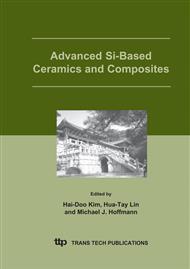p.75
p.85
p.91
p.96
p.102
p.108
p.112
p.117
p.123
Enhanced Sintering of TiB2 with SiC Addition Prepared by Polycarbosilane Infiltration
Abstract:
The sintering of TiB2 was limited due to its high degree of covalent bonding and low self diffusion coefficient. To solve this problem, hot pressing has been used for fabricating TiB2 ceramics, but this process was expensive and limited to the production of simple shapes. Pressureless sintering has also been studied, but its sintering temperatures is, as high as more than 2000°C, resulting in exaggerated grain growth and decrease of mechanical properties. The addition of SiC was found to be effective in improving the densification. However, a supplementary HIP process was needed to enhance the mechanical properties. In this study, the densification behavior and microstructural change of TiB2 ceramics infiltrated by the polycarbosilane of SiC precusor were investigated. The infiltrated polycarbosilane was converted to SiC during heating and densification was accelerated.
Info:
Periodical:
Pages:
102-107
Citation:
Online since:
June 2005
Authors:
Price:
Сopyright:
© 2005 Trans Tech Publications Ltd. All Rights Reserved
Share:
Citation:


